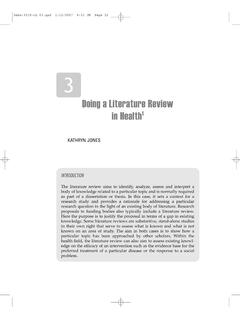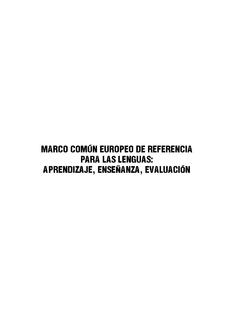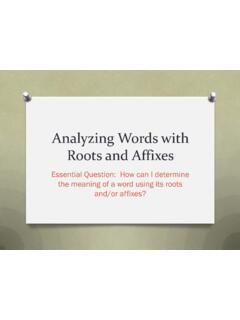Transcription of Chapter 2 Organization of a Research Paper: The IMRAD …
1 Chapter 2 Organization of a Research Paper: The IMRAD FormatAbstractMost scientific papers are prepared according to a format calledIMRAD. The term represents the first letters of the words Introduction, Materialsand Methods, Results, And, Discussion. It indicates a pattern or format rather thana complete list of headings or components of Research papers; the missing parts ofa paper are: Title, Authors, Keywords, Abstract, Conclusions, and , some papers include Acknowledgments and Appendices. TheIntroduction explains the scope and objective of the study in the light of currentknowledge on the subject; the Materials and Methods describes how the study wasconducted; the Results section reports what was found in the study; and the Dis-cussion section explains meaning and significance of the results and providessuggestions for future directions of Research .
2 The manuscript must be preparedaccording to the Journal s instructions to important point to keep in mind is that there is no standard or uniform style thatis followed by all journals. Each journal has its own style; but they all have theirown Instructions to Authors (or other word combinations to mean the same thing).Once you select a journal to which you wish to submit your manuscript, pleaseFOLLOW THE JOURNAL S INSTRUCTIONS TO AUTHORS, which canusually be found in each volume of the journal (note that a volume may containseveral numbers, and there could be multiple volumes in a year), or easily accessedfrom the journal s webpage. Some authors may not be fully convinced about thelogic of some of these instructions, but it is a futile effort to argue with the journalor complain about its instructions. Remember that authors are free to choose froma number of journals in which to publish their scientific papers are prepared according to a standard format calledIMRAD, which represent the first letters of the words Introduction, Materials andMethods, Results, And, Discussion.
3 These do not represent the complete list ofheadings or components of Research papers; the missing parts are: Title, Authors,P. K. R. Nair and V. D. Nair,Scientific Writing and Communicationin Agriculture and Natural Resources, DOI: , Springer International Publishing Switzerland 201413 Keywords, Abstract, Conclusions, And References. Additionally, some papersinclude Acknowledgments and Appendix (Appendices). Sometimes, some sectionsmight be represented and/or amplified by others; , Theory instead of Mate-rials and Methods. Other modifications include combining Results and Discussioninto one section, and including Conclusions as the last part of Discussion. Arecent trend is to give only the main aspects of the paper and post all the additionalor less important aspects as Supplemental Materials on the journal s papers do not have Results and Discussion, and they usually use otherheadings instead of IMRAD headings.
4 The term IMRAD indicates a pattern orformat more than the words covered by the abbreviation. With the AmericanNational Standards Institute (ANSI) adopting the term as the standard, first in 1972and again in 1979 (ANSI 1979), it has become the choice of most Research TitleThe title of the paper will be read more than any other part. The way in which apaper is browsed by readers is in the order: Title Abstract Results (Tablesand Figures) Full paper. The prevailing trend is said to be that, on average, thenumber of readers from one section to the next in the above sequence decreases bya factor of 10. That means for every 10 readers who look at the title, one reads theAbstract; for every 10 who read the Abstract, one goes to the Results section,especially Tables and Figures; for every 10 who read the Results, one reads the fullpaper. Thus, for every person who reads the full paper, 1,000 read the title.
5 Titlesare read both by scientists scanning the contents of a journal and by thosedepending on searches through secondary sources, which always carry the title andauthor but may or may not carry abstracts. The title may be reprinted in bibli -ographies and subject indexes, stored in bibliographic databases and cited in otherarticles. Therefore, the title is an extremely important component of the paper. Agood title will attract readers who might not otherwise read the paper and may helpfuture researchers find important good title of a Research paper should: Contain as few words as possible: many journals limit titles to 12 words Be easy to understand Describe the contents of the paper accurately and specifically Avoid abbreviations, formulas, and jargon Not include any verb Not contain low-impact words such as Some notes , , Investigations , Study , and Effect Not be flashy as in newspapers ( , avoid statements like Agroforestry canstop deforestation ) Report the subject of the Research rather than the results Follow the style preference of the target Organization of a Research Paper.
6 The IMRAD FormatAs Nair (2005) argues, a title such as Plant species found in homegardens inregion A of country B was probably appropriate for an article some 20 years ago,but it is uninspiring to a demanding reader today. The readers know that home-gardens involve multiple species, and if they know the location of the study site,they can guess the species that are likely to be present there. But, if the titlesuggests an innovative investigation such as Does nearness to markets affectspecies composition of homegardens?: A case study fromregion A of country B or Species richness and diversity in homegardens: a boon or bane? it has a muchbetter chance to attract the attention of the discerning, busy important point to remember is that the title, being the first part of the paper,will be browsed by the busy reader, and therefore must be neat, crisp, and coherentto attract the reader s attention.
7 The important words should be placed first andappropriate words should be used to highlight the significant content of the words chosen should also be in a form suitable for abstracting and indexingservices. Jargons and abbreviations should be avoided and, to the extent possible,common names instead of the Latin names of plants (and other living organisms)should be used in the used to be a common practice to publish a series of papers on a subject with amain title and several individual papers with separate sub-titles, often designatedas parts 1, 2, etc. (example: Biomass decomposition in tropical alley cropping: Part1, Part 2,..). This practice caused several difficulties. For example, the continuityof reading is seriously hampered when different parts of a series are published indifferent numbers or volumes of a journal or in different journals, or worst, whenone or more parts never get published.
8 Such individual parts of a series of papersdo not fulfill the essential requirement that each paper should present the resultsof an independent, cohesive study as stipulated in the Instructions to Authors ofmost journals. Therefore, the series of papers is now not favored by most journals(Day 1988).A modification of the series is the hanging title, which is similar to the seriestitle except that a colon replaces the Roman numeral indicating the part of theseries ( , Biomass decomposition in tropical alley cropping: comparison ofcommon multipurpose trees); this practice is still accepted by most journals. Anadvantage of the hanging title is that the most important words of the title could bepresented first, and could therefore be an advantage to the reader. Some authors, inan effort to beat the journal s strict word-limit for titles, argue that the hanging titlebe not counted for the title word count.
9 That will be the editor s journals allow and ask for Running heads. A running head for a paperis an abbreviated title that will be printed as a header on all or alternate pages. Thejournal s instructions will specify the nature of running heads and the maximumnumber of characters, including spaces, allowed. The author should make sure thatthe running head is appropriate to the article in terms of its contents, especially forreview papers and book chapters, where the running head should attract thebrowsing reader s AuthorsThe authors of a paper are individuals who have made an important contribution toplanning and carrying out the Research reported, and anyone listed as an authorshould also have helped in the preparation of the paper. Technicians and otherhelpers are usually mentioned in the authors are listed in the logical order of importance of their contribution tothe work.
10 The person listed first is considered the senior author (unless otherwisespecified); others may be listed according to the importance of contribution to theeffort. Listing authors in alphabetical order is an old practice that is not followedby journals anymore. It is customary to list the graduate student whose thesis ordissertation forms the basis of a paper as the first author followed by his or hermajor supervisor as the second author. In some disciplines, however, the majorsupervisor of a graduate student whose Research is published is listed as the lastauthor. The person to whom correspondence concerning the paper may beaddressed is marked by an asterisk or some other line-up (who and in what sequence) can be a thorny and contentiousissue leading to awkward battles and breach of the high ethical standards thatscientists are expected to uphold.






